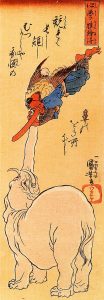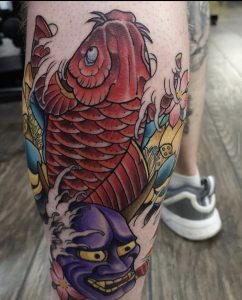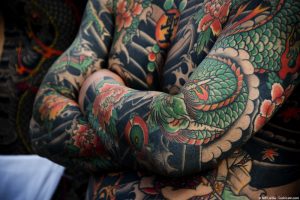Japanese Tattooing – Part II
We continue to dive deeper into Irezumi, the incredibly influential and distinctive style of Japanese tattooing. This post takes a closer look at the mythological iconography and themes of the style, as well as the complicated relationship to tattooing in its origin country.
Iconography
 When you think of mythological creatures, and particularly Japanese mythology, thoughts inevitably turn to dragons. The ryu, the colourful Japanese dragon is considered a symbol of immense strength, wisdom, freedom, luck and blessings. Eastern traditions consider dragons to be generous and use their endowments for good. They help mankind, instead of being greedy and violent.
When you think of mythological creatures, and particularly Japanese mythology, thoughts inevitably turn to dragons. The ryu, the colourful Japanese dragon is considered a symbol of immense strength, wisdom, freedom, luck and blessings. Eastern traditions consider dragons to be generous and use their endowments for good. They help mankind, instead of being greedy and violent.
Not as benevolent are the creatures known as tengu, the nefarious tricksters in Japanese mythology. They play games on people to steer them away from the path to enlightenment. They are thought to be yōkai – supernatural beings, or Shinto kami – gods, and hold places in both Buddhist and Shinto traditions. The tengu spirits used to be thought to take the form of birds of prey, which is why they are still depicted with long noses, often reminiscent of beaks.

Other prominent mythological creatures are the rival Shinto deity brothers Fujin and Raijin. The former can control the wind, and the latter lightning and thunder. Their fighting across the skies is what produces storms.
Perhaps one of the more easily recognizable symbols in Japanese tattooing is that of the Koi. These coloured versions of the Amur carp have been a part of Japanese culture for a long time. They are usually kept in water gardens and can grow to be 25 to 35 years, which, for a fish, is quite a distinguished age. Thus, koi are thought to symbolise longevity, good fortune and perseverance. Different coloured koi are also believed to signify luck in different areas, from career to happiness or love, so it makes sense to do a bit of research if you are planning to get one.
Complicated relationship
Despite the magnificent artistry and rich symbolism, the relationship to tattooing in Japan remains complicated. While attitudes are slowly changing with younger generations, it is still heavily associated with the Yakuza, the infamous crime syndicate. The full-body tattoos favoured by its members can take one or two years to complete, and the ability to stand the pain for that long was evidence that they could commit to long term goals and be trusted.
However, today the Yakuza only has an estimated 30,000 members, and half of them are not “officially” a part of the syndicate, meaning they don’t get tattooed to remain inconspicuous. About 50,000 previous Yakuza have left and are integrating into society. Not an easy task, given the suspicions still lingering against people with body art.
No longer an offence, still not exactly legal

The government removed the labelling of tattooing as a misdemeanour offence in 1948, following the end of WWII. Meanwhile, tattooing remains de facto illegal in Japan, as anyone wishing to perform the procedure of perforating skin must have a medical license.
The law is mostly in place to regulate cosmetic tattooing – it also includes laser hair removal and chemical peels – but has been used by police to raid tattoo shops catering to the Yakuza.
However, there have been instances where authorities have used it to target popular tattoo artists, such as Taiki Masuda. Fortunately, he won his case in court two years ago, sparing him the 300,000 yen fine.
While there are still bans on tattoos in most gyms, onsens, and swimming pools in Japan, attitudes are bound to shift along with generations. If nothing else if the art form becomes so prolific it becomes financially unviable to keep a large segment of potential clientele away from one’s establishment.
